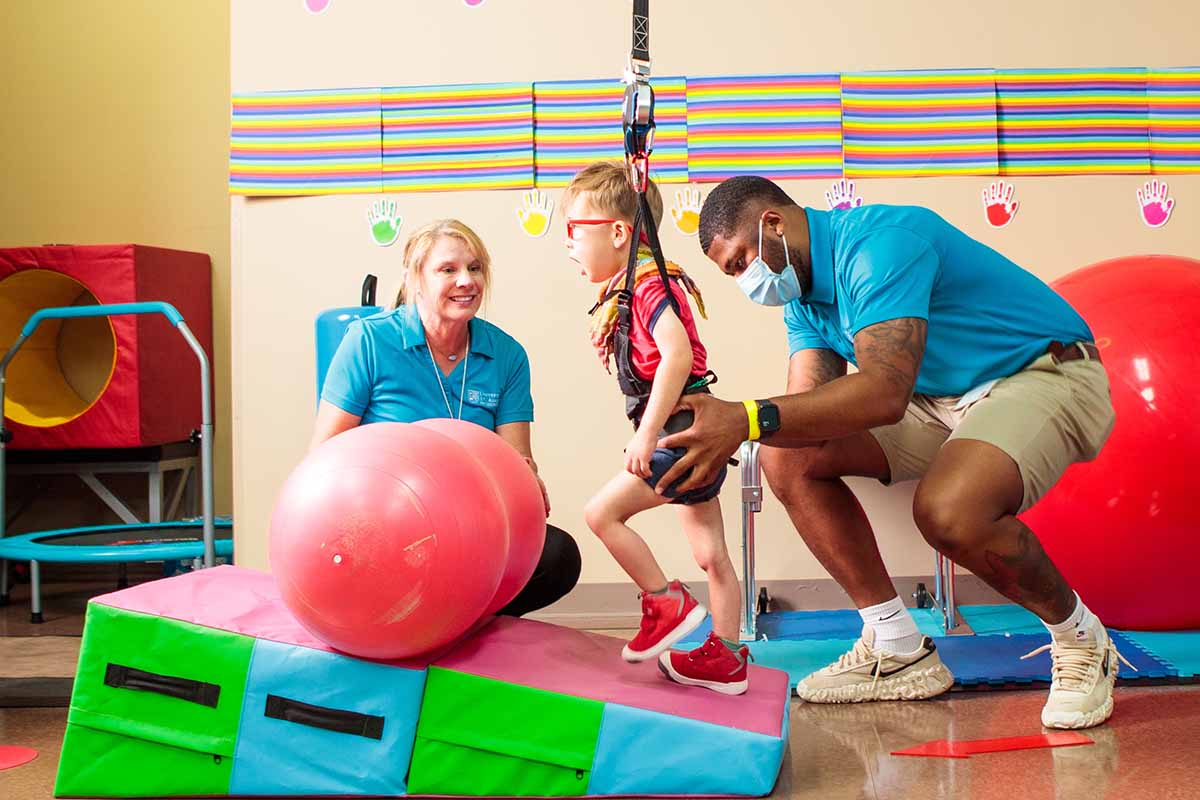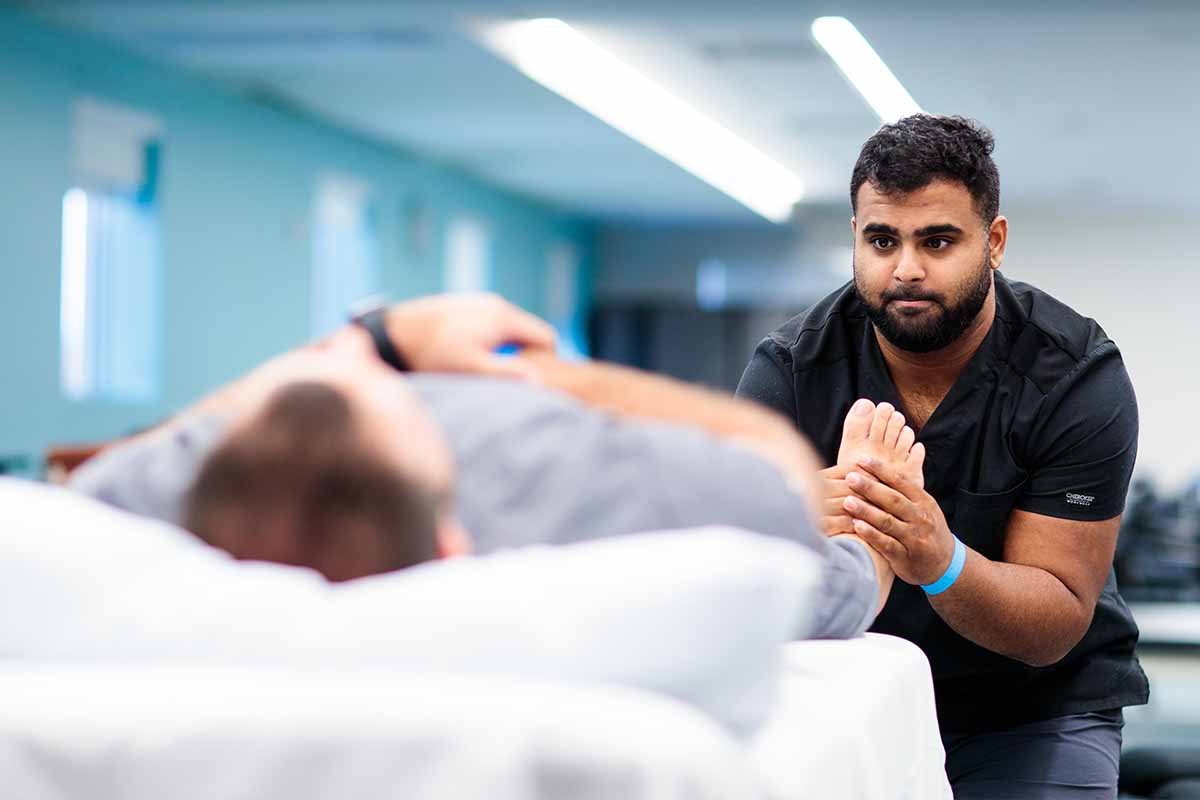

The COVID-19 pandemic compelled many physical therapists (PTs) to pivot to virtual healthcare. As a result, virtual physical therapy, also known as telehealth physical therapy, has rapidly grown and allowed many patients to experience online PT appointments for the first time.
We define virtual physical therapy, explain how it works and discuss its advantages over in-person visits. We’ll also explain how you can become a virtual PT by studying at the University of St. Augustine for Health Sciences (USAHS) Doctor of Physical Therapy (DPT) program.
What Is Virtual Physical Therapy?
Virtual physical therapy refers to any time physical therapists provide services via telehealth.1 Instead of traveling to a clinic for an in-person visit, patients communicate with a licensed virtual PT via phone call or videoconference and attend the appointment from home.
Different PT specialties leverage telehealth in physical therapy. It may be a fit for patients who will benefit from appointments where physical guidance from the PT is not necessary. For example, virtual sessions are a great way to educate patients. Telehealth for physical therapy can also complement in-person sessions.
Before COVID-19, telehealth physical therapy was limited to specific government agencies, such as Veterans Affairs.2,3 However, the COVID-19 shutdown necessitated the quick implementation of virtual physical therapy. A year later, roughly 47% of physical therapy sessions involved telehealth.4
Is Virtual Physical Therapy Effective?
While research is still ongoing, considering the relatively new nature of telehealth, studies have shown that treatment outcomes for virtual physical therapy appear to be on par with the outcomes for face-to-face physical therapy sessions.
- A study published in The Journal of Bone and Joint Surgery showed that telerehabilitation was similarly effective as traditional care for patients recovering from total knee arthroplasty.5
- The Musculoskeletal Journal of Hospital for Special Surgery discovered that, during COVID-19, patient satisfaction with virtual physical therapy was comparable to in-person services.6 The American Physical Therapy Association (APTA) advocates for telehealth as an effective and viable method for delivering patient care.7
Telehealth physical therapy offers little to no patient risk, especially when virtual PT can identify when sessions are helpful and if they have access to the necessary tools to support telehealth.7
Virtual Physical Therapy Is Here to Stay
Telehealth shows no signs of disappearing from the future of physical therapy—while telehealth utilization has fallen since hitting a peak in demand during the COVID-19 pandemic, the telehealth market is still experiencing rapid growth. An average of 22% of adults reported attending a virtual healthcare appointment during four weeks in 2022.8 And the telehealth market is projected to grow nearly 20% by 2030 to a $504.24 billion-a-year industry.9
According to a 2020 study conducted over two months, virtual physical therapy seems to be here to stay, with 94% of physical therapy patients reporting being at least satisfied with virtual physical therapy and 92% reporting they would be willing to attend another virtual physical therapy session.10
To prepare to offer telehealth physical therapy, enroll in a Doctor of Physical Therapy (DPT) program like the dynamic path at USAHS. Our DPT program equips you with the skills and experience of a professional PT, so you’re able to provide virtual physical therapy services.
Many virtual PTs report the lack of touch in telehealth physical therapy requires greater reliance on accurate verbal directions, which is a skill that takes time to learn.11 Developing these skills during your DPT program may help you feel more confident when you begin practicing.
What Does a Virtual Physical Therapist Do?
A physical therapist diagnoses and treats patients with injuries or other health conditions that negatively impact movement or function or cause disability or pain.12 A physical therapist does the same in a virtual setting through videoconferencing or pre-recorded home exercise plan (HEP) videos.13 They demonstrate exercises and stretches for the patient, who then does the same action with the physical therapist. The PT provides verbal feedback to improve their actions.
The physical therapist may suggest the patient use available resources in place of equipment found in traditional physical therapy settings.13 For example, if the patient doesn’t have dumbbells, the physical therapist may ask them to use soup cans or another household item. They may also utilize digital tools like mobile applications to track progress or gamify the recovery process.14
For virtual physical therapy sessions to work, the patient and the virtual PT need a device with video and audio capabilities, a reliable internet connection and videoconferencing software.13 The patient will also need comfortable clothing and a space cleared of obstacles to perform their exercises.


Benefits of Virtual Physical Therapy
Physical therapy offers several benefits when used appropriately.
1. Increases Accessibility
The primary benefit of virtual physical therapy is that patients can access it from anywhere with an Internet connection and connected device.14 As a result, people in geographically remote locations can access a virtual PT without driving long distances.11 It also eliminates barriers such as driving time, wait time in the clinic and transportation costs.13
2. Promotes Patient Engagement
Studies show that virtual physical therapy improves patient adherence to treatment plans and allows asynchronous access to physical therapy between sessions.11, 14 Patients can ask questions or inform their physical therapist of any unexpected changes between sessions, promoting patient accountability. This is especially true when the virtual sessions leverage tools like gamification and reminders.
3. Lowers Costs
Insurance companies often use the same billing codes for in-person and virtual physical therapy sessions, making the costs for telehealth physical therapy similar.13 However, many insurance companies may require an initial in-person visit before covering virtual visits, so ask your insurance provider before you schedule any virtual physical therapy sessions.
If you don’t have insurance, physical therapy typically costs about $75 to $150 for a session, but you may qualify for lower rates if you pay upfront in cash.15
4. Helps Patients Independently Manage Symptoms
Allowing patients to self-manage their symptoms in their homes can grant them a greater sense of independence, making them feel more in control of their recovery process. It may also be helpful to conduct physical therapy telehealth sessions in the same area of the home where patients will be practicing exercises independently. That way, the licensed physical therapist can guide you on using rehabilitative equipment and navigating areas of the home (such as walls, doorways and furniture) within specific exercises.
What to Expect from a Virtual Physical Therapy Session


As a patient looking for physical therapy professionals online, you will need a computer, phone or tablet for your virtual appointment. Your physical therapist may contact you to ask you to download the appropriate videoconferencing platform. Before the session, make sure you have a reliable Internet connection and a space in your home with room to move. Position your device’s camera so your virtual PT can see all your movements.
During the session, your physical therapist may verbally guide your exercises, perform the exercises with you, observe your movements, look for any difficulty of movement and engage in discussion. They may ask you to use furniture, walls or household items to perform exercises or aid in balance.
What Constitutes a Successful Virtual Physical Therapy Session?
It is a physical therapist’s job to help patients regain their range of motion, manage pain and improve their quality of life. During remote sessions, your virtual PT should deliver excellent care. Your virtual PT should express compassion, communicate clearly and encourage questions. They will work with you to make a plan, set realistic goals and help you work toward them.
If you are interested in telehealth physical therapy, contact your virtual PT to create an individualized plan and discuss whether you are a good candidate for virtual sessions.
How to Become a Virtual PT
The requirements to become a virtual PT are the same as becoming a physical therapist:
- Earn a bachelor’s degree.16 Consider one of the best undergraduate degrees for physical therapy.
- Prepare to get into physical therapy school. Many schools require you to complete physical therapy observation hours and several letters of reference. For example, USAHS requires at least 40 physical therapy observation hours but only requires 20 completed hours to apply. If accepted, you must prove you completed the 40 hours before you begin the program.
- Earn a Doctor of Physical Therapy (DPT) from an accredited program. At USAHS, it typically takes 3 years to complete our DPT program and earn your degree.*
- Pass the National Physical Therapy Examination (NPTE).16
- Complete any additional requirements to obtain your license as identified by the state where you want to practice.17 If you want to offer virtual physical therapy in multiple states, gain licensure in each state.
At USAHS, our physical therapy programs include didactic courses, hands-on lab practice with mock patients and supervised clinical rotations. Students learn manual treatment modes to help patients regain movement, lessen pain and live to their fullest potential. During the pandemic, USAHS conducted virtual clinical training to maintain safe learning environments and help future virtual PTs prepare to facilitate telehealth physical therapy.
The largest PT school in the United States,** the University of St. Augustine for Health Sciences (USAHS) offers a hands-on Doctor of Physical Therapy (DPT) degree. Join a collaborative cohort of peers who learn under the mentorship of expert faculty-practitioners. Practice with mock and real patients in our state-of-the-art simulation centers and learn anatomy with our high-tech tools. Prepare for clinical practice with a wide range of patients, as well as for advanced roles in research, practice leadership, and policymaking. Residential (in-person coursework + on-campus labs on weekdays) and Flex (online coursework + immersive hands-on labs on select weekends) formats are available.
*Time to completion may vary by student, depending on individual progress, traditional vs. accelerated pathway, credits transferred and other factors.
**Based on total DPT degrees conferred during 2020-2022, as reported by the Integrated Postsecondary Education Data System (IPEDS). Data is captured by IPEDS through interrelated surveys conducted annually by the U.S. Department of Education’s National Center for Education Statistics (NCES). https://nces.ed.gov/ipeds/
Sources
- American Physical Therapy Association, “Telehealth Physical Therapy Is Provided by Licensed Therapists, Not Technology,” APTA, September 22, 2021, https://www.apta.org/news/2021/09/22/telehealth-provided-licensed-pts.
- M Jake Grundstein, Charles Fisher, Matthew Titmuss, and JeMe Cioppa-Mosca, “The Role of Virtual Physical Therapy in a Post–Pandemic World: Pearls, Pitfalls, Challenges, and Adaptations,” Physical Therapy Journal, June 9, 2021, https://academic.oup.com/ptj/article/101/9/pzab145/6294522.
- Yevgenia Jane Gitlin-Nitti, Chirag D. Sah, et al., “A Physical Therapist’s Role in Clinical Video Telehealth,” Federal Practitioner, July 2015; 32(7): 40-41, https://www.ncbi.nlm.nih.gov/pmc/articles/PMC6363294/.
- Matthew J Miller, Sang S Pak, et al., “Physical Therapist Telehealth Delivery at 1 Year Into COVID-19,” Journal of the American Physical Therapy Association, November 2022, https://www.ncbi.nlm.nih.gov/pmc/articles/PMC9494451/.
- Janet Prvu Bettger, Cynthia Green, et al., “Effects of virtual exercise rehabilitation in-home therapy compared with traditional care after total knee arthroplasty,” The Journal of Bone & Joint Surgery, January 15, 2020; 102(2):101-109, https://journals.lww.com/jbjsjournal/fulltext/2020/01150/effects_of_virtual_exercise_rehabilitation_in_home.2.aspx.
- Erica Fritz Eannucci, Kayla Hazel, et al., “Patient Satisfaction for Telehealth Physical Therapy Services Was Comparable to That of In-Person Services During the COVID-19 Pandemic,” HSS Journal, November 2020;16:10-16, https://www.ncbi.nlm.nih.gov/pmc/articles/PMC7571303/.
- American Physical Therapy Association, “Telehealth Advocacy,” APTA, 2024, https://www.apta.org/advocacy/issues/telehealth.
- Euny C. Lee, Violanda Grigorescu, et al., “Updated National Survey Trends in Telehealth Utilization and Modality (2021-2022),” Assistant Secretary for Planning and Evaluation, April 19, 2023, https://aspe.hhs.gov/sites/default/files/documents/7d6b4989431f4c70144f209622975116/household-pulse-survey-telehealth-covid-ib.pdf.
- Fortune Business Insights, “Telehealth Market Size, Share & COVID-19 Impact Analysis, By Type (Products and Services), By Application (Telemedicine, Patient Monitoring, Continuous Medical Education, and Others), By Modality (Real-time (Synchronous), Store-and-forward (Asynchronous), and Remote Patient Monitoring), By End-User (Hospital Facilities, Homecare, and Others), and Regional Forecast, 2023-2030,” Fortune Business Insights, May 10, 2024, https://www.fortunebusinessinsights.com/industry-reports/telehealth-market-101065.
- Matthew J Miller, Sang S Pak, et al., “Evaluation of Pragmatic Telehealth Physical Therapy Implementation During the COVID-19 Pandemic,” Journal of the American Physical Therapy Association, January 2021, https://www.ncbi.nlm.nih.gov/pmc/articles/PMC7665714/.
- Neta Roitenberga and Noa Ben-Ami, “Qualitative exploration of physical therapists’ experiences providing telehealth physical therapy during COVID-19,” Musculoskeletal Science & Practice, August 2023; 66:102789, https://www.ncbi.nlm.nih.gov/pmc/articles/PMC10257945/.
- American Physical Therapy Association, “Becoming a Physical Therapist,” APTA, 2024, https://www.apta.org/your-career/careers-in-physical-therapy/becoming-a-pt.
- Ana Gascon Ivey, “Telehealth Physical Therapy: The Guide to Virtual PT,” GoodRX, February 24, 2023, https://www.goodrx.com/healthcare-access/telehealth/telehealth-physical-therapy.
- American Physical Therapy Association, “The Digitally Enabled Physical Therapist: An APTA Foundational Paper,”APTA, November 2022, https://www.apta.org/contentassets/e37aa1765cab4b1791d22717d3ac20af/apta-digital-health-foundational-paper-2022.pdf.
- Ortho Bethesda, “How Much Does Physical Therapy Cost?” Ortho Bethesda, 2024, https://www.orthobethesda.com/blog/how-much-does-physical-therapy-cost/.
- U.S Bureau of Labor Statistics, “Physical Therapists: How To Become a Physical Therapist,”BLS, April 17, 2024, https://www.bls.gov/ooh/healthcare/physical-therapists.htm#tab-4.
- American Physical Therapy Association, “Licensure,” APTA, 2024, https://www.apta.org/your-practice/licensure.








